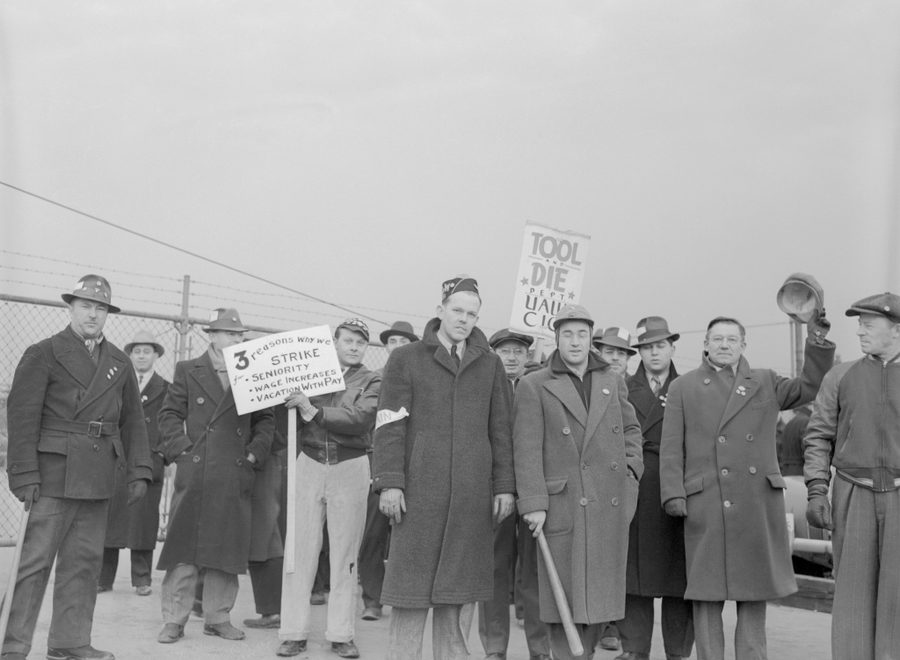Get Rid of No-Strike Clauses and Stop Begging
The right to strike is the only thing that gives working people power. Let’s stop bargaining it away.
Hamilton Nolan

Two of the candidates running for president of a 100,000-member public employee union in California, SEIU Local 1000, have a notable plank in their platforms: they want to get no-strike clauses out of their union contracts. They have an uphill battle, in large part because, on this particular issue, the labor movement will tend to act as a rock pulling them down, rather than helping them up.
In post WWII America, union contracts work more or less like this: The company guarantees workers certain wages and benefits, and the workers agree to give up their right to strike for the term of the contract. This fundamental agreement — material gains in exchange for labor peace — defines modern labor relations. And where has this arrangement gotten the labor movement? Near death. For decades, union membership has declined, wages have stagnated, and capital has gained more and more power over working people.
This devastating collapse in the power of organized labor has coincided with the post “Treaty of Detroit” period in which a very dangerous idea was cemented and enshrined as conventional wisdom. That is the idea that employers agree to union contracts in order to purchase labor peace—that the incentive for a company to bargain and sign a contract with its workers is to receive, in turn, a guarantee that those workers will be quiescent.
Today, the belief in the necessity of this arrangement prevails among management-side attorneys, labor-side attorneys, and union leaders alike. Indeed, it is embodied very well in this quote that the Sacramento Bee got from labor attorney Tim Yeung when asking about the proposal to get rid of no-strike clauses: “It’s all about labor peace,” Yeung said. “When we agree to a contract, we’re agreeing that for the next three years or whatever, we’re not going to have a strike. If you can walk out at any time, that defeats much of the purpose of what we’re trying to do.”
Let me suggest a different, more reasonable framework for labor relations between an employer and its employees. The employer signs a union contract in order to buy the work the employees do. Labor peace is something that the employer purchases separately, by being a good employer, and not fucking the employees over. The basic act of enshrining a mundane agreement on wages and working conditions in a contract should rightly be seen as a normal part of doing business, not as something that working people have to fight to gain at the expense of their own rights. What a business gets in return for a union contract is a work force. What the workers get is freedom from having the terms of their employment radically upended at any moment. To our jobs, we should be obligated to give our time and our effort, but not our souls.
The right to strike is, at the end of the day, the only thing that gives working people power. The only thing! Withholding our labor is the one and only weapon we have that can match the power that capital has — the economic power to render people destitute, a fearsome power that is every bit as threatening as guns and bombs. Any working person individually can be destroyed by that power. Collectively, however, working people can match that power by striking and forcing capital to grind to a halt. No set of laws, regulations, or contractual provisions will ever change the fact that this is the only balance of power that exists in a capitalist workplace. We are fed the illusion that giving up the right to strike in exchange for material gains is an even trade. But that’s not true. For a little bit of money, businesses gain freedom from the one thing that can make them negotiate evenly with their workers. They maintain their own economic weapons over their workers, while we willingly lay down ours and tell ourselves that we have won something.
The practical effect of no-strike clauses is to produce obedient unions whose real power is confined to brief periods during contract bargaining, and no other time. I have had personal experience on both sides of this. I once worked at a company under a union contract that did not have a no-strike clause. When problems arose — and they did — we forced the company to sit down and meaningfully bargain with us to work things out. They knew that if they didn’t, we would walk out. The union was strong, and won meaningful gains we wouldn’t have otherwise had. Then we signed a second contract that included a no-strike clause. After that, the new owners proceeded to treat the union with disdain and commit various outrages with impunity, secure in the knowledge that we would keep working no matter what. By giving up our right to strike, we had sentenced ourselves to forced humiliation that could not be balanced out by any number of social media campaigns or outraged statements by the union.
I am not going to lie to you: getting rid of ubiquitous no-strike clauses in union contracts (without some kind of national legislation) will be like trying to pull an old growth tree out by the roots. Once they’re in there, they stay in there. Most employers will not willingly sign a contract without them. This means that workers will be required to strike in order to win their own right to strike. That is not an easy task, because most union members are not big ideologues but rather normal people mostly concerned with pay and healthcare, unwilling to risk their entire livelihoods to win something so seemingly abstract. Given the awful consequences that can come with losing a job, it’s hard to blame anyone for that.
This is not an issue to be rested on the shoulders of every workplace individually. This is something the entire labor movement needs to recognize is a problem. The big treaty between capital and labor has ended up being about as balanced as the treaties between the United States government and Native Americans. We don’t need to wait another 50 years to figure this out. For now, there needs to be an effort to identify and seek out specific unions and specific contracts that can be targeted as battlefields to have the fight over doing away with no-strike clauses. They might be high-income workers, who have a better safety net, or particularly ideological workers, who are willing to fight on principle, or workers with ostentatiously liberal employers who are vulnerable to losing this battle on the merits. All of these places are out there. The more contracts that can be signed without no-strike clauses, the more the precedent will be established, and the more it will be possible for companies and workers alike to see that everything doesn’t fall apart as a result. (In These Times, for example, has a union contract containing the right to strike, and it’s still standing.)
We don’t need to keep taking a dollar today and then eating shit for the next three years. Instead, let’s make the boss treat us nice every day. Because they know what will happen if they don’t.
Hamilton Nolan is a labor writer for In These Times. He has spent the past decade writing about labor and politics for Gawker, Splinter, The Guardian, and elsewhere. More of his work is on Substack.







